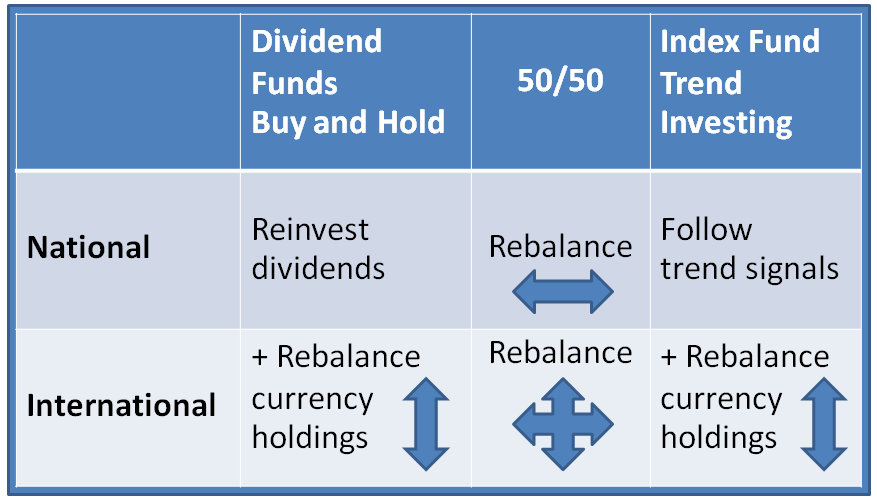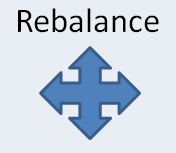The Stock Investing Strategy Framework
Here is a framework that may help you in selecting a stock investing strategy that suits you. Different investing strategies carry different types of risks. You have to make choices here. You cannot invest and avoid all the risks. But here there is a framework that gets you a step closer.
Personally I like to avoid the risk that my investments are losing a large part of their value during a down-turn in the markets that lasts longer than 6 months or even years. On the other hand I can accept the risk that I miss out occasionally a few months on a short-term market rally when I have just sold my funds to avoid a possible down-turn.
Your attitude towards risk may be different. The beauty of investing in stock markets is that there is a good strategy for everyone.
In summary, the stock investing strategy framework described here is based on diversifying your holdings over different investment strategies. Optionally, you can also diversify your holdings simultaneously over different geographical and currency areas. And then by re-balancing your holdings regularly, you improve your long-term returns and mitigate the risks of the different strategies and currencies. I’ll explain it all here below.
Which strategy would work for you depends on a number of different factors.
- What risks do you want to avoid?
- What time do you have available to manage your investments?
- What skills do you have to manage your investments?
Keep these aspects in mind when you read on to find out what choices you have and to learn that you also can go for “the middle road”.
The Regional Dimension
In a previous blog post, I have told you about why you may want to invest internationally and take a currency risk. In another article, you can read how to avoid the currency trap when you do decide to invest in international stock markets.
The decision to invest only nationally or also internationally is one dimension in our stock investing strategy framework.
What percentage of your savings you would want to invest internationally is a personal choice. Read here what my own asset allocation has been.
The other dimension is about a using a passive buy and hold strategy or a more active long-term trend following (index fund trend investing) approach.
The Investing Strategy Dimension
This stock investing strategy framework that you read about here provides 3 strategy choices:
- Buy and Hold a Dividend Funds
- Trend Following with Index funds
- Combine the previous 2 strategies (the middle road)
One extreme is to invest 100% of your savings in a “Buy and Hold a Dividend Fund” strategy. The other extreme is to apply a trend following with index funds approach to 100% of your savings that are earmarked for investing in the stock market. Read this article to get more insight in the different type of risks that both strategies invoke.
But there is a third alternative. This is the middle road. That is the Buddha approach. You do not choose to go for the full 100% for one of the extremes. You do both. You can for example use 50% of your capital to the ‘Buy and Hold a Dividend” strategy and 50% to the Trend Following approach.

The Stock Investing Strategy Framework
The Beauty of Re-balancing Your Stock Holdings
The beauty now comes when you regularly rebalance between the two strategies. Thus when after a period, one strategy with your 50% has been more successful than the other, you take money out of that approach and put it into the other one, to bring the balance back to 50/50. Or if you can invest new capital, you invest less in the one who has done best and more in the other, to bring the balance back to 50/50.
Thus assume this scenario. Suppose that over a period of time, the Trend Following 50% has done better than the Dividend 50% and the ratio has shifted to 55/45. To re-balance this, you need to buy more Dividend Funds. And the only way that the ratio could have shifted to the 55/45 is when the dividend fund is now relatively cheap compared to the other more successful strategy.
And thus you stock up now extra of these dividend funds for a good price that you pay for with money that you have earned with a strategy that has delivered better returns than these funds. That is pure gain.
Again Buy Low and Sell High… Also Geographically
On the other hand, assume that the market has fluctuated sideways for a while. In that case, the dividend fund could have provided a better return than the trend following approach. To re-balance now, you use part of your relative higher dividend returns to put more money in your trend following approach.
At this moment the dividend fund is relatively high and price and the trend following portfolio is relatively cheap. Again you sell high and buy low.
Re-balancing is often used as a concept to bring your actual asset allocation between stocks and bonds back to your target allocation. I think that the concept works even better in an approach as described here. Read here more about “re-balancing” in general terms.
To bring your investment strategy back in balance, you do not only re-balance between “buy and Hold” and “Trend Following”, you also re-balance between “National” and “International”. The same re-balance benefits apply here.
Conclusions
Thus there is a third way for you if you do not feel comfortable with a 100% Buy and Hold or a 100% Trend Following approach for your investments in the stock market. You can apply both to 50% of your holdings and re-balance when your portfolio has grown out of balance.
The same you can apply to your decision what percentage to invest in national and international stock markets. When investing, the middle of the road can be nice place to be.
Such an approach softens the risks of the more extreme approaches and provides a more stable return on your investments and a more stable value level of your holdings.
Share any questions or comments you may have here below and please tell your friends about this “middle of the road” stock investing strategy via Facebook, Google+ and Twitter (click those buttons). Here you can get our free newsletter that can help you to get better investing and trading returns.
Next & Previous Blog Post
- ‹ previous
- 144 of 174
- next ›



